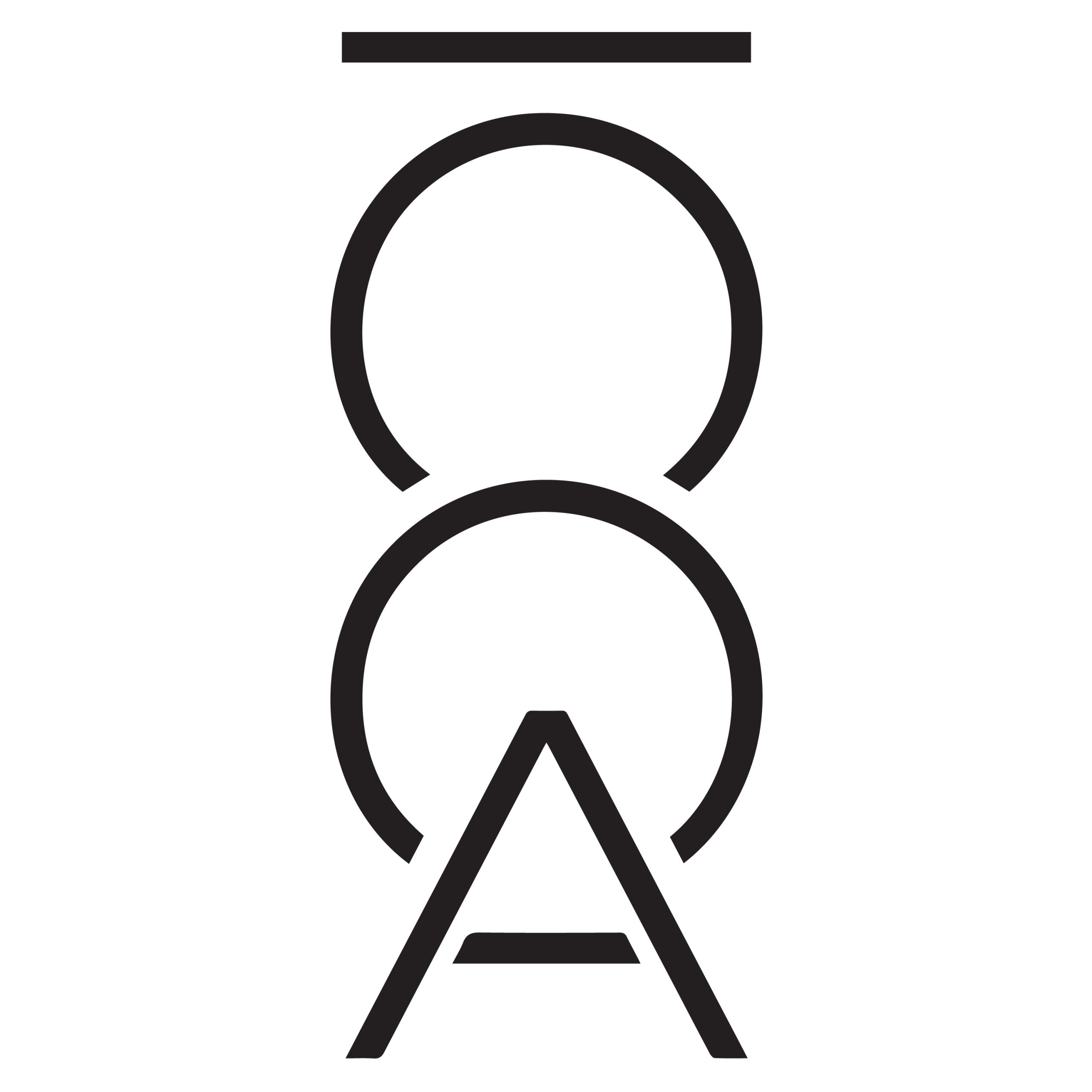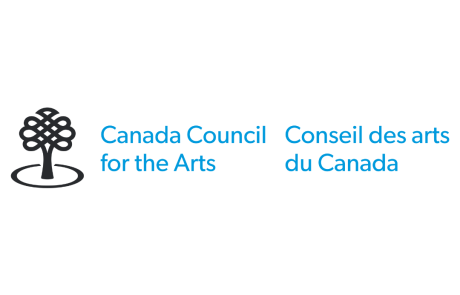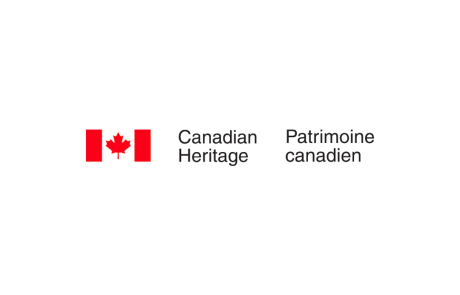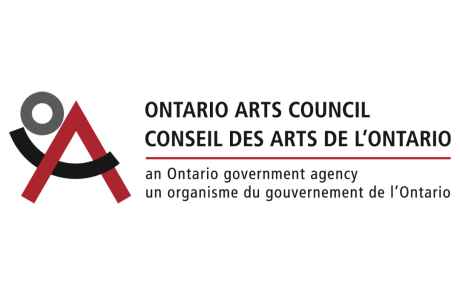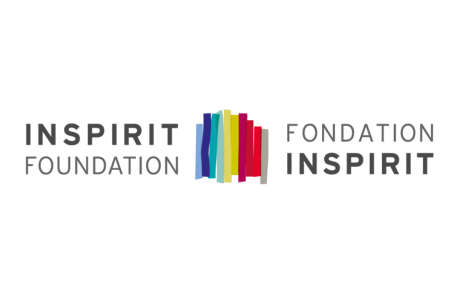Echo Lines: Denewa
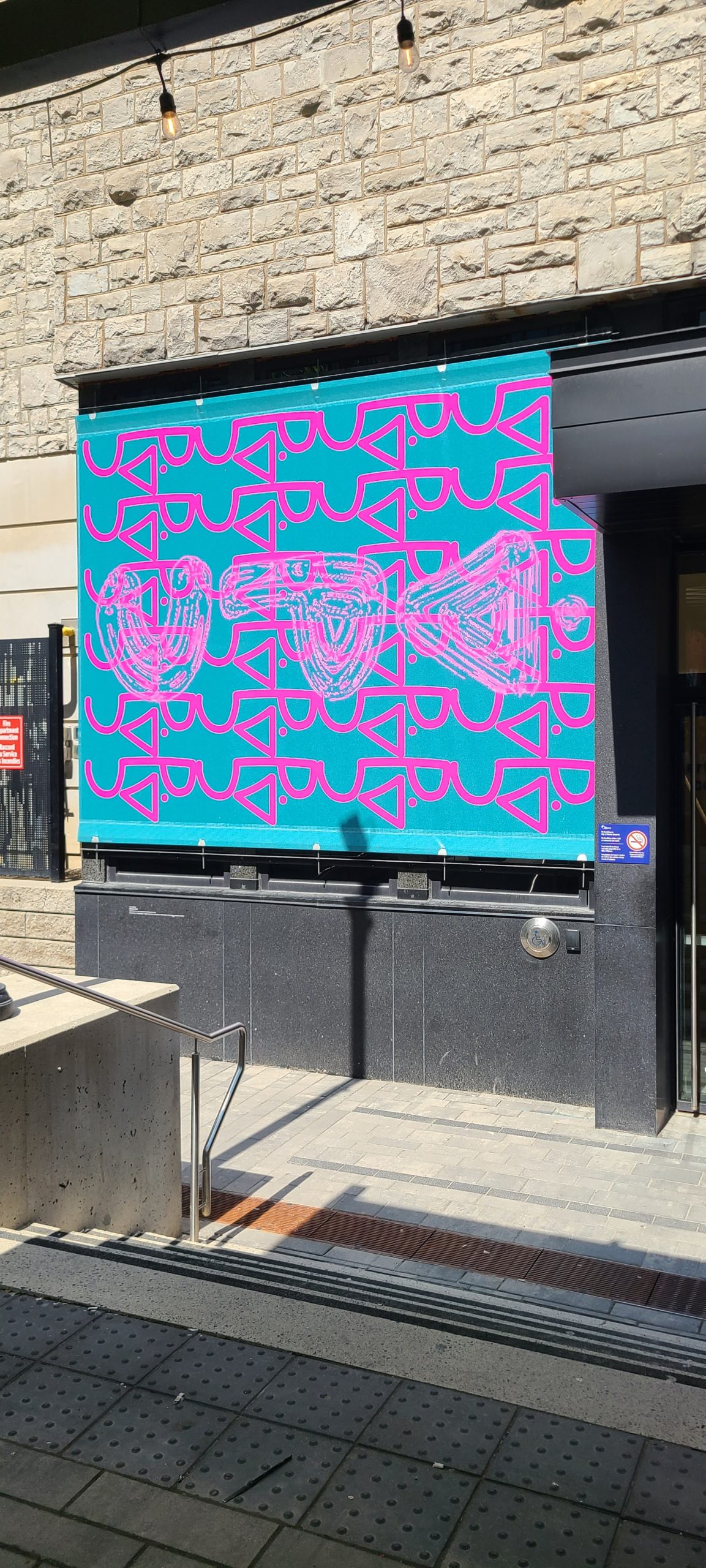
Echo Lines Installations Ottawa 2025, Photography Credit to Bella Adrian Photos
Echo Lines: Curatorial Mentorship Program
Denewa
Curatorial Essay by Danielle Printup and Joi T. Arcand
Denewa, Laura Grier’s (Sahtu Délı̨nę) first work on vinyl, extends their critical engagement with Dene aesthetics through the lens of digital materiality and experimental print processes. Installed as a large-scale digital print on vinyl within the courtyard at SAW Gallery, a key site of artistic resistance and experimentation within Canada’s cultural landscape, Denewa is both a personal and communal act—a mood, an aesthetic drift, a glow-lit hum of soft rebellion and neon intimacy, suspended somewhere between refusal and dreaming.
Laura Grier is an artist and printmaker based in Tkaronto. With a BFA from NSCAD University, an MFA from OCAD University, they are currently pursuing a PhD at York University. Their work emerges at the intersections of academic inquiry, lived experience, and expansive creative practice.
As described in Dene Aesthetics: A Run-On Theory (2024), Grier’s art explores what they describe as “a Dene knowledge structure that encompasses this weird Urban/ Sadgirl/ Girl/ Sleep Deprived/ Fluorescent/ Artbrat/ Dreaming/ Mumbling/ Relational/ Synthetic/ Dene renderings of being.” Their practice articulates a singular, affective Dene aesthetic while envisioning futures in which “sparkly pan-Dene weirdos take over the world.”
Central to Grier’s practice is a commitment to material experimentation and the printed form. Their approach to printmaking is reciprocal, treating tools and materials as animate, relational beings. In Denewa, this ethos finds new expression within the synthetic realm, where the vinyl surface becomes a site of contradiction. The work is industrial, yet intimate and public, and deeply personal. The choice to use a digitally rendered surface is not merely technical; it is an extension of Grier’s ongoing dialogue with process and spirit.
Influenced by the work of Indigenous theorists such as Heather Ahtone (Chickasaw) and Leanne Betasamosake Simpson (Michi Saagiig Nishnaabeg), Grier infuses their work with layered meanings, some accessible, some intentionally withheld. In Denewa, abstraction, repetition, and multidimensionality function as strategies of expression and recognition for those who share the code, who know what to look for.
For Grier, the Dene language is a direct portal to the expansive knowledge systems held by their ancestors. Each word earned becomes a reflection of the complex labour of reclamation, shaped by what they describe as “a starvation of love, or connection.” It is this acute awareness of displacement that drives their sustained effort to return. The work of language learning is thus both an intellectual pursuit and an affective commitment to repair and belonging. Quick, consumable access stands in direct opposition to the prolonged, engaged intentionality required by Indigenous languages. Installed within SAW’s concrete gathering grounds, at the heart of Ottawa’s urban artscape, Denewa transcends spatial boundaries. It asserts presence, relation, and Indigenous futurity through radical visibility and quiet codes. It holds space for dreamers, disrupters, and those still searching. In doing so, it reminds us that the grounds it rests on are not neutral. It is art made in relation and in resistance, on unceded Algonquin land.
For this installation, Denewa was positioned at the threshold between the gallery and street, where artists linger, smoke, and trade stories, to invite new forms of encounter and reciprocity, echoing Dene laws of sharing and relationality.
Artist-run centres like SAW have long supported artists who challenge conventions and reimagine artistic possibilities. In the Canadian context, these spaces have been crucial sites for Indigenous artists in asserting sovereignty over narrative, aesthetics, and process. In choosing to install Denewa at SAW, Grier steps into the legacy of resistance while actively contributing to its evolution. At 12 feet wide, the work’s monumental scale, along with its bright pink Dene syllabics, and the synthetic sheen of vinyl channel what scholar Jillian Hernandez (Black/Lantinx) defines as the “aesthetics of excess,” (2020) rendering Indigenous joy and struggle hyper-visible on its own terms.
Yet, beneath the manufactured surface of Denewa lies an undercurrent of love, struggle, and longing. Grier’s work not only asserts Dene presence but actively seeks connection, belonging, and the possibilities of future Dene worlds. For them, the printed form, whether handmade or synthetic, is a vessel for these desires, carrying stories, jokes, gossip and codes that resonate across generations and communities.
Denewa, by Laura Grier (Sahtu Délı̨nę First Nations, living in Tkaronto) is a digital print on vinyl that was presented by the ICCA and SAW Gallery (Ottawa) on June 12, 2025 as part the ARCA Gathering, Against the Current. Curated by Danielle Printup (Hodinohso:ni/Anishinaabe, living in Ottawa) and Joi T Arcand (Muskeg Lake Cree Nation, living in Ottawa).
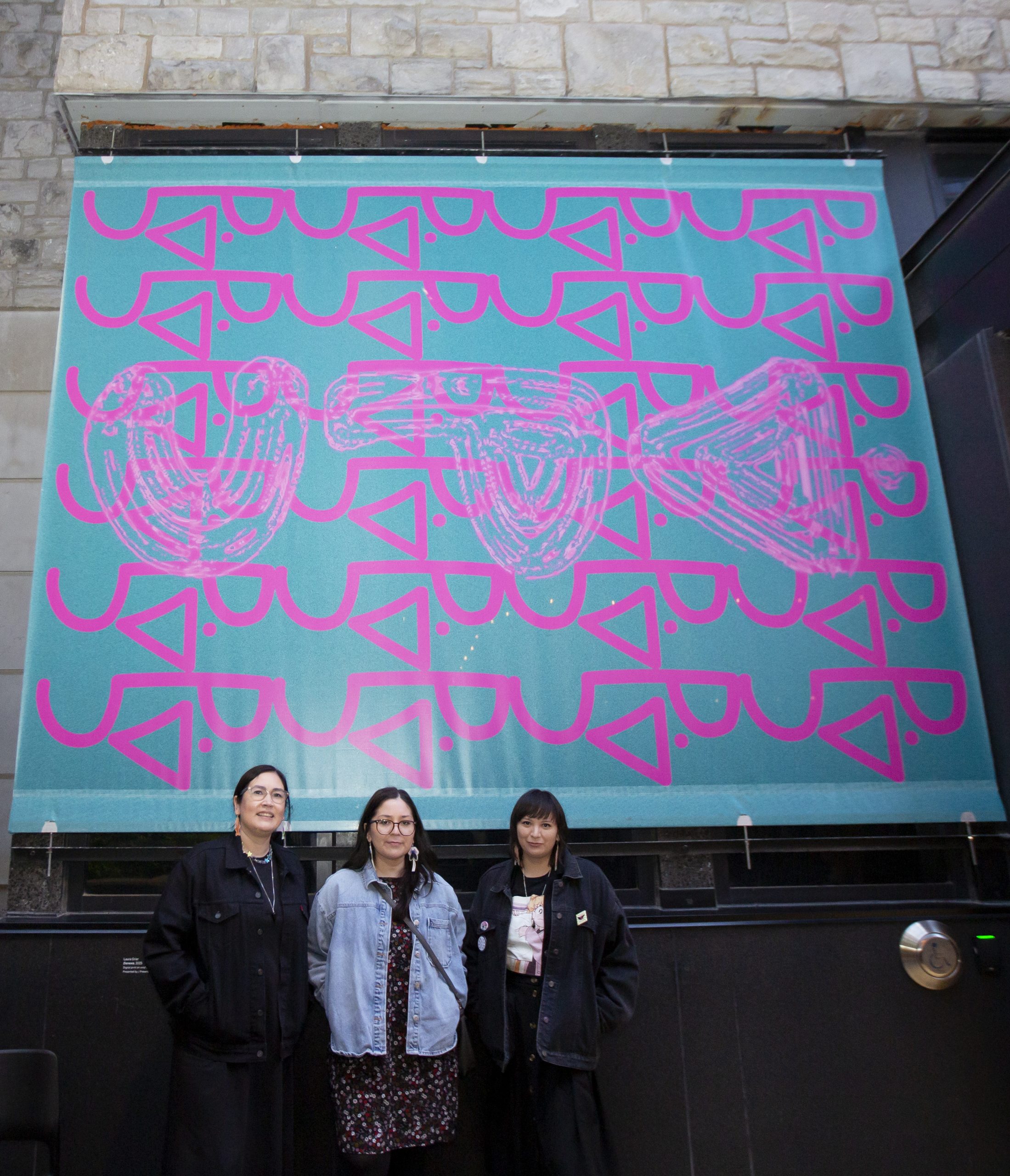
Echo Lines Installations Ottawa 2025, Photography Credit: Tracey Lynne Photography
Curatorial Mentee
 Joi T. Arcand is an artist from Muskeg Lake Cree Nation, Saskatchewan, Treaty 6 Territory, currently residing in Ottawa, Ontario. She received her Bachelor of Fine Arts degree with Great Distinction from the University of Saskatchewan in 2006. In 2018, Arcand was shortlisted for the prestigious Sobey Art Award. Her practice includes installation, photography and design and is characterized by a visionary and subversive reclamation and indigenization of public spaces through the use of Cree language and syllabics.
Joi T. Arcand is an artist from Muskeg Lake Cree Nation, Saskatchewan, Treaty 6 Territory, currently residing in Ottawa, Ontario. She received her Bachelor of Fine Arts degree with Great Distinction from the University of Saskatchewan in 2006. In 2018, Arcand was shortlisted for the prestigious Sobey Art Award. Her practice includes installation, photography and design and is characterized by a visionary and subversive reclamation and indigenization of public spaces through the use of Cree language and syllabics.
Recent solo exhibitions include Central Art Garage (Ottawa, ON); College Art Galleries (Saskatoon, SK); ODD Gallery (Dawson City, Yukon); Mendel Art Gallery (Saskatoon); Wanuskewin Heritage Park (Saskatoon); Dunlop Art Gallery (Regina). Her work has been included in numerous group exhibitions, including Àbadakone at the National Gallery of Canada (Ottawa, ON) and INSURGENCE/RESURGENCE at the Winnipeg Art Gallery.
Arcand has been artist-in-residence at Wanuskewin Heritage Park (Saskatoon); OCAD University (Toronto); Plug-In Institute of Contemporary Art (Winnipeg); the Banff Centre for Arts and Creativity; and Klondike Institute of Art and Culture (Dawson City, Yukon); and Harbourfront Centre (Toronto).
She was the co-founder of the Red Shift Gallery, a contemporary Indigenous art gallery in Saskatoon. She was founder and editor of the Indigenous art magazine, kimiwan (2012-2014). She has curated various exhibitions including Language of Puncture at Gallery 101 (Ottawa, 2017), nākatēyimisowin an outdoor mural exhibition in Ottawa. In her role as Director of SAW Gallery’s Nordic Lab she curated The Travellers (Supermarket Art Fair, Stockholm, Sweden, 2018). She recently graduated from University nuhelotʼįne thaiyotsʼį nistameyimâkanak Blue Quills and is a member of the art and curatorial collective: Wolf Babe.
Curatorial Mentor
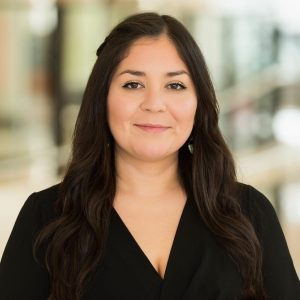 Danielle Printup (she/her) is a Hodinohso:ni (Onondaga) / Anishinaabe (Algonquin) arts worker and curator from Kitigan Zibi Anishnabeg, QC, with maternal roots in Ohsweken, ON. She has a Bachelor of Honors in Art History from the University of Guelph (2012). She has interned at the National Gallery of Canada and completed the RBC Indigenous Training Program in Museum Practices at the Canadian Museum of History. She has worked at Galerie SAW Gallery, the Indigenous Art Centre and the City of Ottawa’s Public Art Program. She is the Indigenous Cultural Engagement Coordinator at Carleton University Art Gallery. Her most recent curatorial projects include curating a solo exhibition of Christian Chapman’s work titled “Run to the Hills!” and a co-curated exhibition with Carmen Robertson of Norval Morrisseau’s work titled “Medicine Currents,” which were both presented during the fall of 2023 at the Carleton University Art Gallery. She is a member of the Wolf Babe Collective, a group of curators and artists who create work that draws from their experiences as racialized First Nations non-binary people and women. She is currently enrolled in the Masters Program in Art & Architectural History at Carleton University.
Danielle Printup (she/her) is a Hodinohso:ni (Onondaga) / Anishinaabe (Algonquin) arts worker and curator from Kitigan Zibi Anishnabeg, QC, with maternal roots in Ohsweken, ON. She has a Bachelor of Honors in Art History from the University of Guelph (2012). She has interned at the National Gallery of Canada and completed the RBC Indigenous Training Program in Museum Practices at the Canadian Museum of History. She has worked at Galerie SAW Gallery, the Indigenous Art Centre and the City of Ottawa’s Public Art Program. She is the Indigenous Cultural Engagement Coordinator at Carleton University Art Gallery. Her most recent curatorial projects include curating a solo exhibition of Christian Chapman’s work titled “Run to the Hills!” and a co-curated exhibition with Carmen Robertson of Norval Morrisseau’s work titled “Medicine Currents,” which were both presented during the fall of 2023 at the Carleton University Art Gallery. She is a member of the Wolf Babe Collective, a group of curators and artists who create work that draws from their experiences as racialized First Nations non-binary people and women. She is currently enrolled in the Masters Program in Art & Architectural History at Carleton University.
The curatorial essays presented as part of Echo Lines are supported by the Indigenous Curatorial Collective / Collectif des commissaires autochtones (ICCA) through its Curatorial Mentorship Program. This program fosters mentorship between emerging and established Indigenous curators, encouraging collaborative exhibition-making, research, and critical writing rooted in Indigenous knowledge systems and collective practice. Through Echo Lines, participants co-developed new exhibitions and essays that reflect intergenerational dialogue, cultural continuity, and the diverse curatorial voices shaping the future of Indigenous contemporary art.

